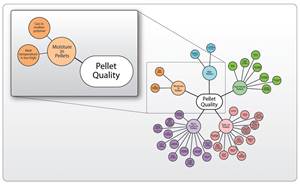‘Lean’ Molding & Liquid Color: A Good Fit
If you want to take up parasailing, it’s probably best that you have no fear of heights.
If you want to take up parasailing, it’s probably best that you have no fear of heights. If you want to go where few if any large-part blow molders have gone before, it’s probably best if you have no fear of failure.
Such was the mindset of Hayward Pool Products, Clemmons, N.C., which injection and blow molds a wide range of pool products. In 2008, the molder switched from using pellet concentrates to liquid colors on three large blow molding machines producing housings for filter tanks, a move considered risky by most blow molding pundits.
The switch to liquid color, supplied by Riverdale Color Co., Perth Amboy, N.J. (riverdalecolor.com), is among the more recent changes made by Hayward as part of an ongoing process that started in the late 1990s to streamline its manufacturing processes. “Before 1999, we were a typical U.S. manufacturer,” remarks Scott Pugh, Hayward’s heat-pump and filter manufacturing manager. “Production was not tied to demand. We were overproducing, had inventory everywhere, and needed more space just for storage.”
Hayward worked with consultants and in late ’99 revamped its operation to incorporate “lean” manufacturing techniques advanced by the likes of Toyota years before. To go lean, Hayward had to revamp its processing operation entirely—no small feat when you consider the thousands of different parts of all sizes it molds and welds. Gone were the long assembly lines, replaced by U-shaped manufacturing cells where components are injection and blow molded and assembled into complete parts by one operator.
The desire to produce products on demand and reduce inventory also encouraged Hayward to replace more traditional dry colorants with liquid. “As we went lean, we had to make shorter runs of multiple products, and respond quickly to demand,” Pugh explains. “With dry color, the time it took us to change over was posing a huge problem. We’re talking about cleaning a huge accumulator head weighing 50,000 lb. You can’t take it apart, material tends to hang in there, and it was taking us up to 25 hr just to switch from one color to another.”
As part of its continuous-improvement initiative, Hayward assembled a project team to look at every aspect of the problem…more than once. “Our culture encourages us to try things and not be afraid of failure,” states Pugh. “We knew that in order to even try to run liquid, for example, we had to rebuild our screws, which cost us $70,000 on the three blow molders. But we made the investment before we even had an inclination of the result.”
After several trials, involving multiple liquid-color vendors, different formulations, and machine modifications, Hayward went with Riverdale’s Pump-in-a- Drum liquid color system combined with a weigh-scale blender furnished by Riverdale sister company Maguire Products, Aston, Pa. (maguire.com). Pugh summarizes the benefits:
- Huge reductions in scrap due to color changes. A black-to-platinum switch used to take 300 parts to finish. Now it takes fewer than 20.
- Faster changeovers, resulting in lower inventories yet improved customer deliveries.
- Elimination of landfill-bound purgings.
- Lower storage space requirements than for pellet colorants.
- Reduced cycle times.
- Ability to reuse liquid containers.
- Reduction in regrind fines.
“It took persistence to bring liquid color use to fruition at Hayward,” Pugh says. “A culture of continuous improvement provided us with a foundation to move forward.” Pugh says the results have been so impressive that Hayward is mulling a move to liquid for injection molding as well.
Related Content
What to Know About Your Materials When Choosing a Feeder
Feeder performance is crucial to operating extrusion and compounding lines. And consistent, reliable feeding depends in large part on selecting a feeder compatible with the materials and additives you intend to process. Follow these tips to analyze your feeder requirements.
Read MoreMore Than a Compounder: They Have the Science to Create New Custom Materials
Insight Polymers & Compounders leverages its expertise in polymer chemistry to develop next-generation materials.
Read MoreGreen’s the Theme in Extrusion/Compounding
The drive toward circular economy is requiring processors to make more use of PCR. Machine builders at K—across all extrusion processes—will be highlighting innovations to help them do just that.
Read MoreThe Path to Pellet Perfection
In underwater pelletizing, numerous variables in the equipment, process and material affect pellet shape, consistency and quality factors such as fines. Defining the “perfect” pellet depends on the conditions of end use, and achieving that ideal requires understanding of the causes of imperfections.
Read MoreRead Next
Understanding Melting in Single-Screw Extruders
You can better visualize the melting process by “flipping” the observation point so that the barrel appears to be turning clockwise around a stationary screw.
Read MoreHow Polymer Melts in Single-Screw Extruders
Understanding how polymer melts in a single-screw extruder could help you optimize your screw design to eliminate defect-causing solid polymer fragments.
Read MoreLead the Conversation, Change the Conversation
Coverage of single-use plastics can be both misleading and demoralizing. Here are 10 tips for changing the perception of the plastics industry at your company and in your community.
Read More













.png;maxWidth=300;quality=90)












